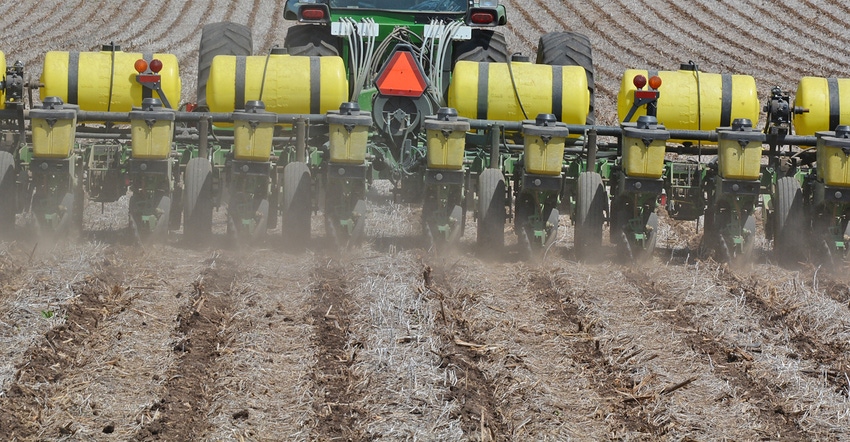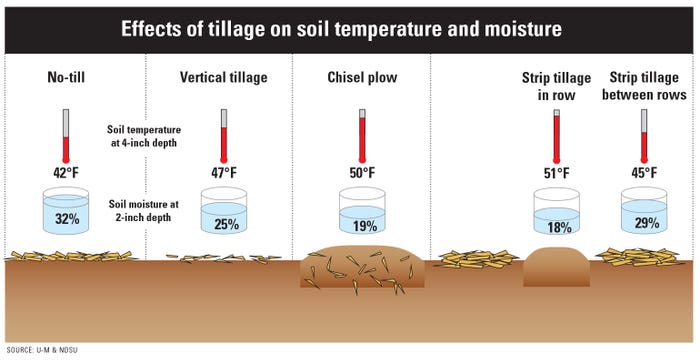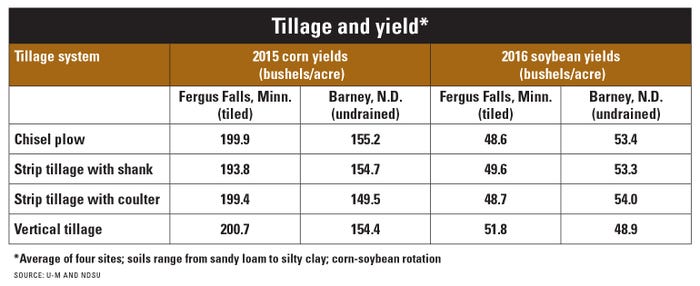October 26, 2017

By Dorian Gatchell
Cold and wet soil.
Those are the main reasons Minnesota growers are reluctant to farm with more crop residue. A thick mat of residue slows soil warming and drying in the spring, which can delay planting, hinder crop emergence and cut yield potential.
However, a new study from the University of Minnesota and North Dakota State University shows that the seedbed warms and dries just as fast with strip tillage as with a conventional chisel-plow system.
Strip tillage, which is relatively new in Minnesota and the Upper Midwest, leaves two-thirds of the soil surface undisturbed. Seeds are placed in a 10-inch-wide tilled strip, or berm. Fertilizer is usually banded beneath the strips.
The new study, carried out in 2015 and 2016 at four sites in Minnesota and North Dakota, tested four tillage methods, plus no-till. Tillage systems included:
• chisel plow plus spring cultivation
• fall strip tillage with shanks
• spring strip tillage with coulters
• vertical tillage
Test variables included:
• Soil temperature
• Soil water content
• Grain yield
The on-farm sites, near Fergus Falls, Minn., and Wahpeton, N.D., included a range of soil textures, from sandy loams to silty clays. Two sites had subsurface drainage and two did not. All sites were in a corn-and-soybean rotation.
The research was sponsored by the Minnesota Corn and Soybean Growers and the North Dakota Corn and Soybean Councils with checkoff dollars.

SOIL TEMPERATURE AND TILLAGE: A recent tillage study by the University of Minnesota and North Dakota State University compared soil temperatures and moisture at four field sites. The chisel-plow and strip-till systems produced the warmest and driest soil conditions for planting. No-tilled and vertically tilled soils were cooler and wetter. (Source: “Reducing Tillage Intensity,” Daigh, A., North Dakota State University, and DeJong-Hughes, J. University of Minnesota, 2017)
Temperature, moisture findings
The chisel-plow and strip-till systems produced the warmest and driest soil conditions for planting. As expected, no-tilled and vertically tilled soils were cooler and wetter.
Spring soil temperatures were measured at a 4-inch depth and were the same in the chisel-plowed soils and the strip-tilled berms — averaging about 8 degrees F warmer than no-till soil temps. The findings were consistent across all the soil types and locations, says study leader Jodi DeJong-Hughes, a U-M tillage specialist. The research shows that soil temperatures depend more on where crop residue is placed than the percent of soil covered, she says.
Likewise, spring soil moisture was measured at a 2-inch depth and was no different in the chisel-plowed soils and the strips, which were both about 40% drier than no-till.

TILLAGE YIELD IMPACT: In two-year field trials by the University of Minnesota and North Dakota State University, tillage generally did not affect corn and soybean yields. The exception was strip tillage with shanks on clay loam soils near Fergus Falls, Minn., in 2015. Lower corn yield was likely due to wet soil conditions during strip tillage, which caused soil smearing. No yield differences could be attributed to differences in springtime soil warming and drying, says study leader Jodi DeJong-Hughes, University of Minnesota tillage specialist. (Source: Jodi DeJong-Hughes, University of Minnesota, and Aaron Daigh, North Dakota State University, 2017)

Moisture levels in the undisturbed zones between the strips were similar to no-till. The residue-covered zones help preserve that extra moisture for later in the season — one of the advantages of strip-till.
Corn and soybean yields did not differ significantly by tillage system or location in either 2015, when spring moisture was average, or in 2016, a dry spring. The one exception was a fall strip-tilled field in 2015: Corn yield fell by about 6 bushels per acre due to wet tillage conditions, which caused soil smearing, DeJong-Hughes says. No yield differences could be attributed to disparities in springtime soil warming and drying, she adds.
“Overall, strip-till tended to present the best of both chisel-plow and no-till management,” she says.
Nutrient efficiency gains
I work with quite a few growers who are seeing good results with strip-till.
One of the biggest advantages we’ve seen is better nutrient efficiency. Placing immobile nutrients in a subsurface band under the strips reduces phosphorus tie-up in the soil. It also alleviates vertical nutrient stratification, which leads to a concentration of nutrients near the soil surface, where they are subject to loss from erosion.
Strip-till also costs less than a conventional chisel-plow system, saving about $25 per acre in corn and $13 per acre in soybeans, according to recent U-M estimates.
That said, strip-till requires a significant equipment investment.
If you’d like to try strip-till on your farm, I suggest you start with strips for soybeans, which are more forgiving of planting errors than corn. If you can hire a custom strip-tiller, that’s a good way to get a feel for it. Start small — a few acres or a field.
Strip-till tips
Here are some additional observations about strip till, drawn from our experiences:
• Put a skillful operator in the tractor. The strips must be built correctly and uniformly, or you’ll have erosion and planting problems.
• Residue managers are a must. Properly adjusted row cleaners on the planter are necessary to avoid residue in the strip and seed furrow. Other planter adjustments may also be needed for satisfactory performance in a high-residue environment.
• Chopped corn residue can interfere with strips. It works best to cut cornstalks off higher at harvest and avoid chopping them, so loose residue doesn’t blow or wash over the strips.
• Your weed control program will change. You’ll need an effective spring burndown. As you disturb the soil less, the weed spectrum will shift to more perennials — such as dandelions — and more shallow-emerging annual grasses and small-seeded broadleaves. Disease and insect shifts can also happen.
• Networking is helpful. The best way to learn the nuts and bolts of strip-tilling is from experienced farmers. Find knowledgeable people and ask lots of questions.
Gatchell is a certified crop adviser from Granite Falls, Minn., and owner of Minnesota Agricultural Services. He is a frequent collaborator in University of Minnesota field trials. Find information and links to Minnesota CCAs at mcpr-cca.org.
You May Also Like




